
Leiden University is a public research university in Leiden, Netherlands. It was founded as a Protestant university in 1575 by William, Prince of Orange, making it the oldest institution of higher education in the Netherlands.

Sandra Moore Faber is an American astrophysicist known for her research on the evolution of galaxies. She is the University Professor of Astronomy and Astrophysics at the University of California, Santa Cruz, and works at the Lick Observatory. She has made discoveries linking the brightness of galaxies to the speed of stars within them and was the co-discoverer of the Faber–Jackson relation. Faber was also instrumental in designing the Keck telescopes in Hawaii.
Rychard J. Bouwens is an associate professor at Leiden University. He is also a former member of the Advanced Camera for Surveys Guaranteed Time Observation team and postdoctoral research astronomer at the University of California, Santa Cruz. He obtained his bachelor's degree in physics, chemistry, and mathematics from Hope College. He then went on to earn his Ph.D. in physics at the University of California, Berkeley under the supervision of Joseph Silk and also worked with Tom Broadhurst.
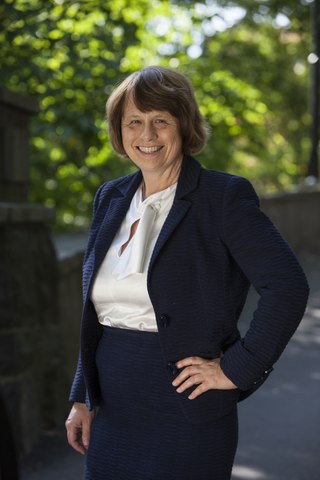
Ewine Fleur van Dishoeck is a Dutch astronomer and chemist. She is Professor of Molecular Astrophysics at Leiden Observatory, and served as the President of the International Astronomical Union (2018–2021) and a co-editor of the Annual Review of Astronomy and Astrophysics (2012–present). She is one of the pioneers of astrochemistry, and her research is aimed at determination of the structure of cosmic objects using their molecular spectra.

The Spinoza Prize is an annual award of 2.5 million euro prize money, to be spent on new research given by the Dutch Research Council (NWO). The award is the highest scientific award in the Netherlands. It is named after the philosopher Baruch de Spinoza.
Harvey Raymond Butcher III is an astronomer who has made significant contributions in observational astronomy and instrumentation which have advanced understanding of the formation of stars and of the universe. He received a B.Sc. in Astrophysics from the California Institute of Technology in 1969, where he contributed to the development of advanced infrared spectrometry applied in the first survey of the sky at infrared wavelengths.
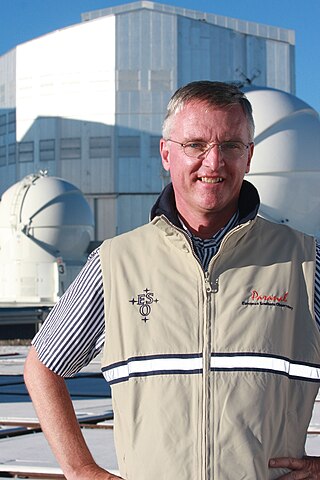
Pieter Timotheus "Tim" de Zeeuw is a Dutch astronomer specializing in the formation, structure and dynamics of galaxies. From 2007 to 2017 he was the director general of European Southern Observatory. He is married to astronomer Ewine van Dishoeck. In May 2022, Leiden University suspended him after an internal review concluded that over several years he repeatedly belittled and insulted women in public and abused his position of power as a professor by threatening to damage their scientific careers; and that in addition to intimidation and inappropriate behavior there was "a component of sexual harassment". The Max Planck Institute for Extraterrestrial Physics announced that they will no longer work with him and the European Southern Observatory banned him from accessing their premises.
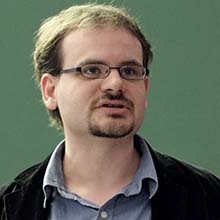
Christopher J. Conselice is an astrophysicist who is Professor of Extragalactic Astronomy at the University of Manchester.

UDFj-39546284 is a high-redshift Lyman-break galaxy discovered by the Hubble Space Telescope in infrared Hubble Ultra-Deep Field (HUDF) observations in 2009. The object, located in the Fornax constellation, was identified by G. Illingworth, R. Bouwens and the HUDF09 Team during 2009 and 2010. It was reported with a redshift of z~10 using Hubble and Spitzer Space Telescope photometric data, with later reports in 2012 suggesting a possibly higher redshift of z = 11.9 Although doubts were raised that this galaxy could instead be a low-redshift interloper with extreme spectral emission lines producing the appearance of a very high redshift source, later spectroscopic observations by the James Webb Space Telescope's NIRSpec instrument in 2022 confirmed the galaxy's high redshift to a spectroscopically confirmed estimate of z = 11.58.
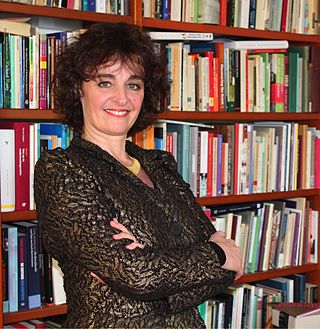
Patricia Maria (Patti) Valkenburg is a Distinguished Professor of Communication at the University of Amsterdam. She is the founder and director of Center for research on Children, Adolescents, and the Media (CCAM). She is a fellow of the International Communication Association. In 2011, she received the Spinoza Prize, the highest Dutch award in science.

Alexander Godfried Gerardus Maria (Xander) Tielens is an astronomer at Leiden Observatory, Leiden University, in the Netherlands. In 2012 he received the highest distinction in Dutch science, the Spinoza Prize.

MACS0647-JD is a galaxy with a redshift of about z = 10.7, equivalent to a light travel distance of 13.26 billion light-years. If the distance estimate is correct, it formed about 427 million years after the Big Bang.

Corinne Lisette Hofman FBA is a Dutch professor of Caribbean Archaeology at Leiden University since 2007. She was a winner of the 2014 Spinoza Prize.
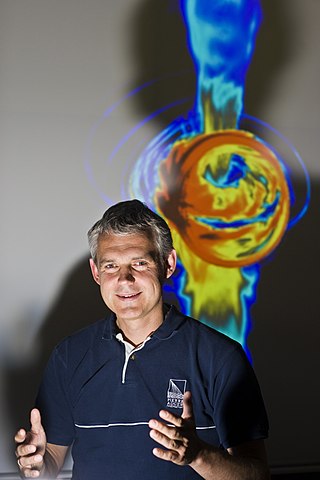
Heino Falcke is a German Dutch professor of radio astronomy and astroparticle physics at the Radboud University Nijmegen. He was a winner of the 2011 Spinoza Prize. His main field of study is black holes, and he is the originator of the concept of the 'black hole shadow'. In 2013, a team under his lead earned a 14 million euro research grant from the European Research Council to further studies of black holes. In 2019, Falcke announced the first Event Horizon Telescope results at the EHT Press Conference in Brussels.

Ineke Sluiter is a Dutch classicist and professor of Greek Language and Literature at Leiden University since 1998. Her research focuses on language, literature, and public discourse in classical antiquity. She was a winner of the 2010 Spinoza Prize. Sluiter has been president of the Royal Netherlands Academy of Arts and Sciences since June 2020, and previously served as vice president from 2018 to 2020.

Michel D. Ferrari is a Swiss neurologist and professor of neurology at Leiden University and Leiden University Medical Center. He was a winner of the 2009 Spinoza Prize. He is considered to be the foremost migraine expert of the Netherlands, as well as one of the six top scientist in the field worldwide.
George Kildare Miley is an Irish-Dutch astronomer. He holds a professorship at Leiden University, where he served as director of Leiden Observatory from 1996 to 2003.

Amina Helmi is an Argentine astronomer and professor at the Kapteyn Astronomical Institute at the University of Groningen in the Netherlands.

Jane Rebecca Rigby is an American astrophysicist who works at the Goddard Space Flight Center and is Senior Project Scientist at the James Webb Space Telescope. She was selected one of Nature's 10 Ones to Watch in 2021 and Shape 2022.















